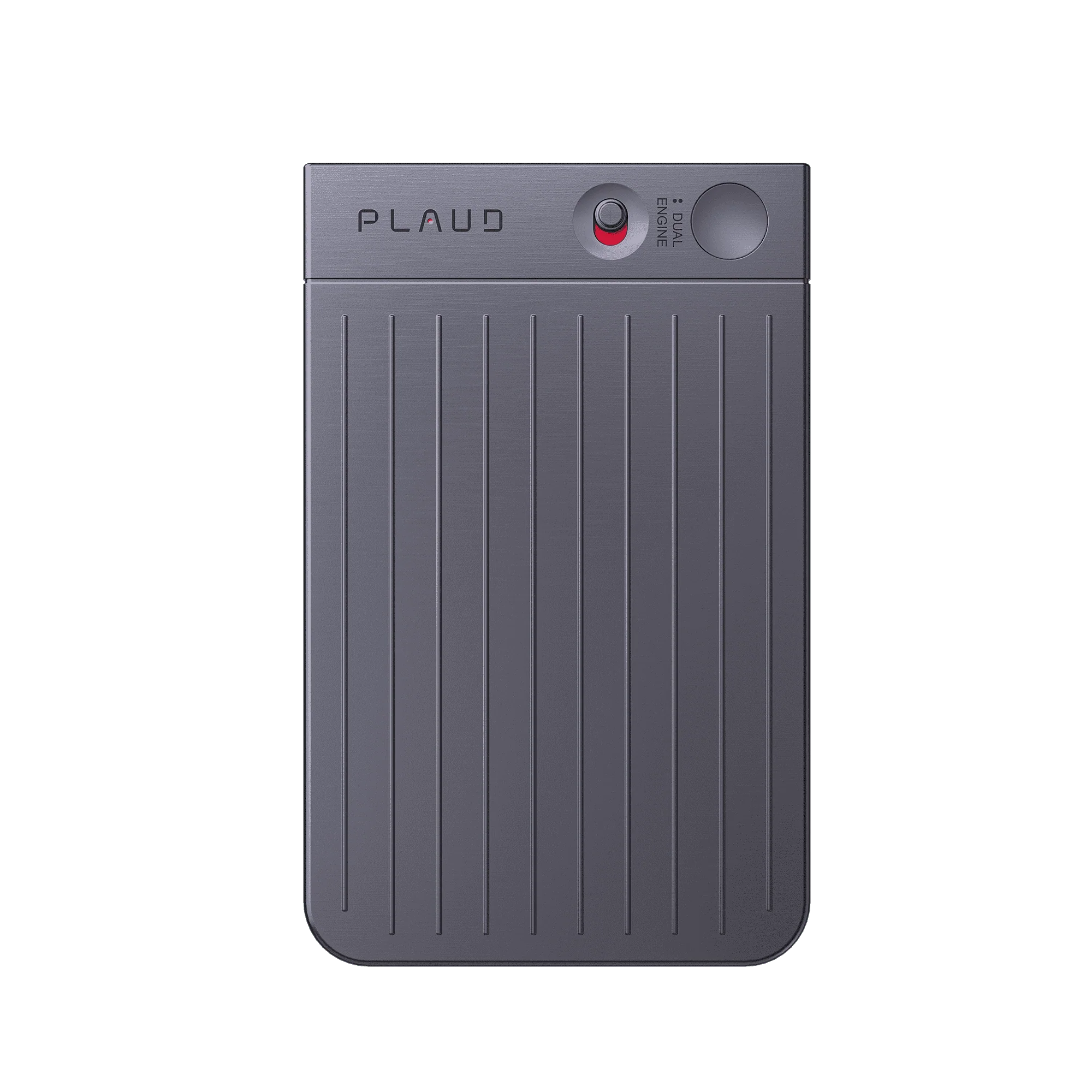Legal Disclaimer:
Recording laws vary across the U.S. Some states require only one party to consent and in these states, the person making the recording can be that consenting party. Other states follow two-party (all-party) consent, meaning every participant must agree to the recording. Secret recording without permission can be illegal. Always check your local laws and use hidden recorders responsibly and ethically.
In this review, we take an in-depth look at the PLAUD hidden voice recorder, a slim, credit-card sized gadget designed to record conversations discreetly and intelligently. We’ll cover its features and real-world performance (including a continuous 28-hour recording test), compare it against Google’s Recorder app on Pixel phones, discuss who will benefit most from such a device and provide a clear-eyed evaluation of its pros and cons.
The PLAUD hidden voice recorder offers 28 hours of continuous recording, fast cloud sync, and highly accurate speaker-separated transcription. A discreet, reliable tool for interviews, meetings, and long sessions.
- 28h of continuous recording
- Fast wireless transfer
- Unlimited cloud sync
- Clear speaker-separated transcription
- Discreet and lightweight design
- Web interface for desktop access
- Only 5h/month free Transcription
- Manual activation for Fast Transfer
- Cannot capture Bluetooth headsets
What Is PLAUD and Who Is It For?
PLAUD is a thin, credit-card-sized recorder designed to capture audio discreetly. Because it does not look like a traditional recording device, it can fit into contexts where a visible microphone or a smartphone might feel more intrusive. The concept targets users who want a dedicated tool without relying on a phone: journalists, students, note-takers, and anyone who needs a compact recorder.
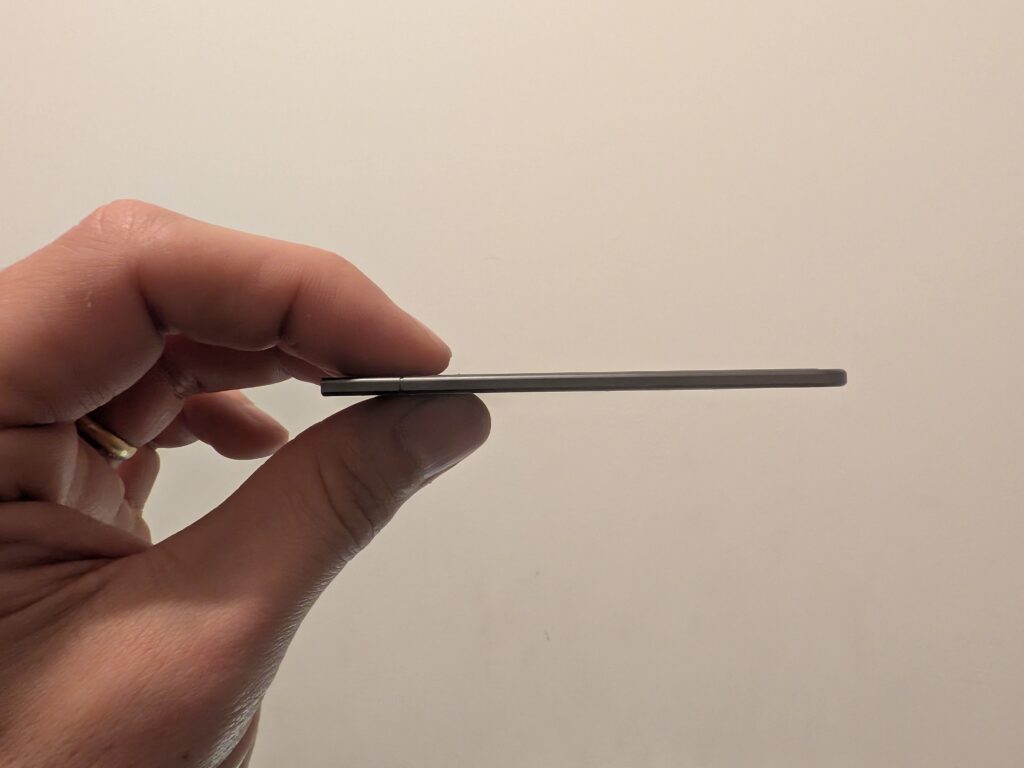
The device promises long battery life, onboard storage, and the possibility to transcribe audio through an app. These promises formed the basis of the tests performed for this review.
First Contact and Setup with this hidden voice recorder
The PLAUD Note is extremely lightweight. Setup requires pairing it with the mobile application, but once done, the recorder can function independently. For users accustomed to smartphone apps, the absence of a touchscreen on the device itself may require a short adaptation period. However, the goal of the hardware seems to be simplicity: one button for recording, no interface to manage during the moment.
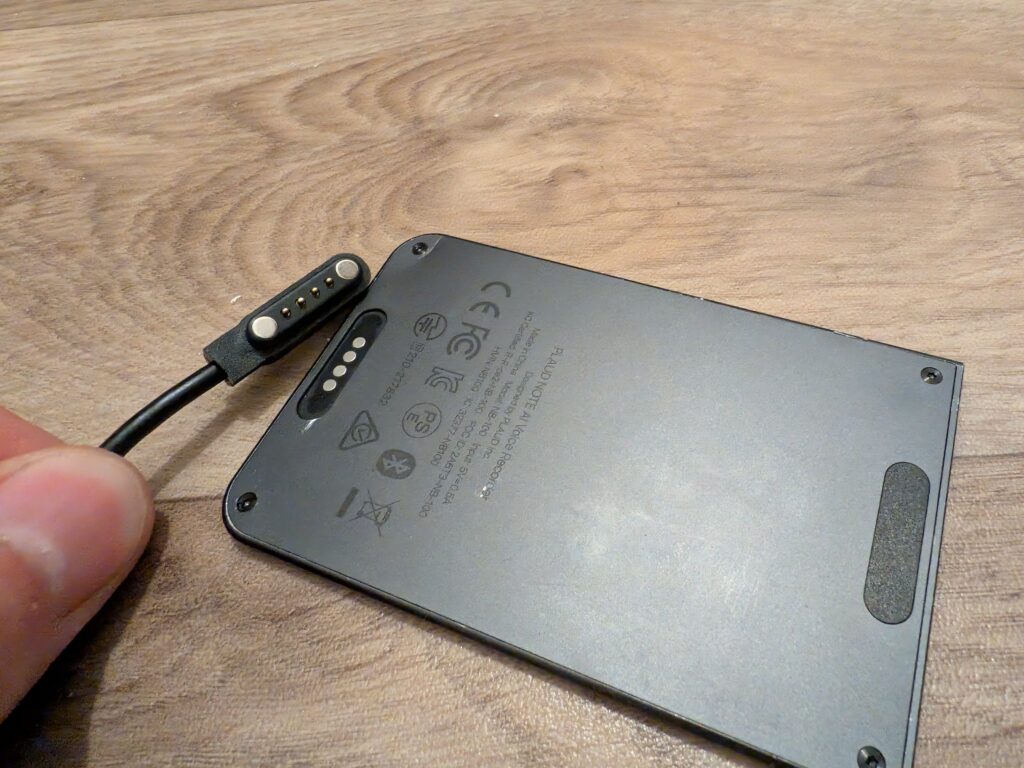
The magnetic accessory designed for attaching the recorder to a smartphone is optional. It becomes relevant only if the user intends to record phone calls.
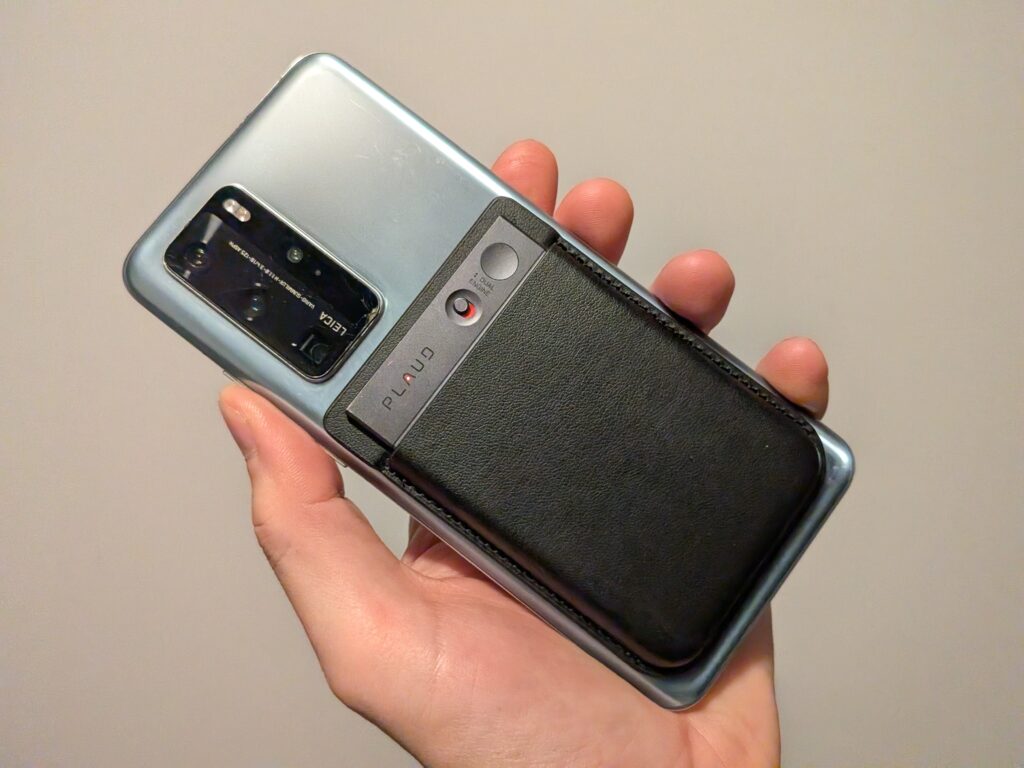
Recording Test: 28 Hours in One Charge
A large part of this review focused on observing how a hidden voice recorder behaves during long sessions. To evaluate the device, we launch a continuous recording session until the battery reached zero.
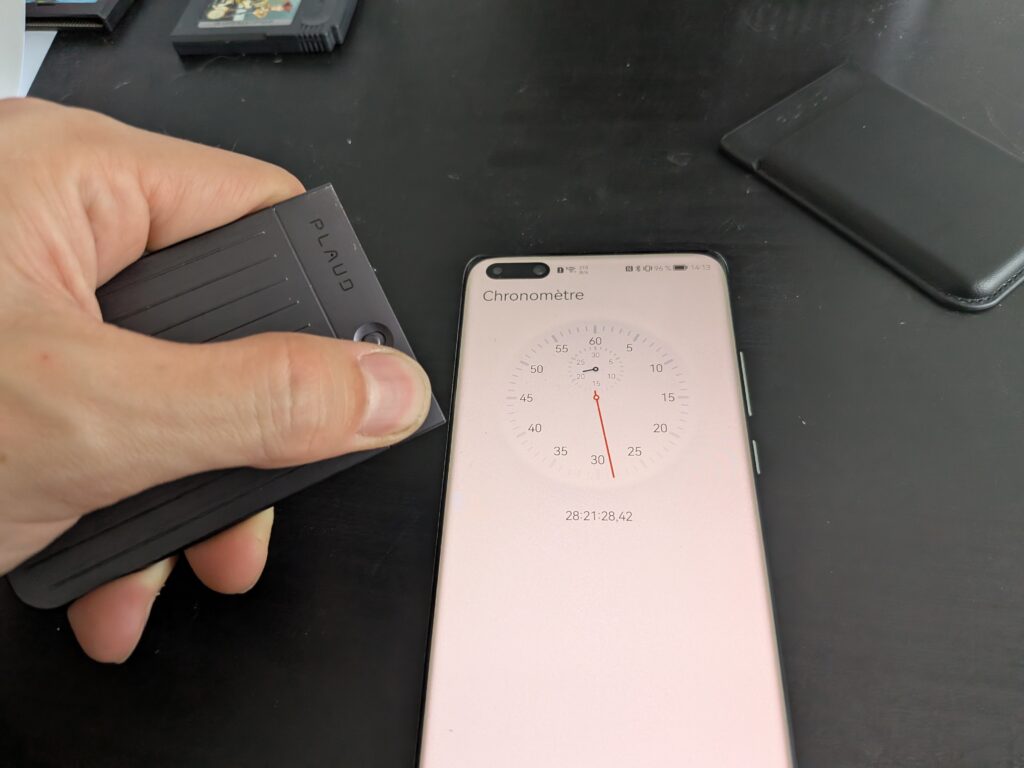
Result: approximately 28 hours of continuous recording.
This result is consistent with the specifications by the manufacturer. Such endurance is unusual in comparison to typical smartphone apps, limited by phone battery life. For users who attend long conferences, travel, or conduct multiple interviews in a day, this autonomy may be meaningful.
During the 28-hour session, no unexpected interruption occurred. The file generated was large but handled correctly by the device.
Charging and Transfer Speed of this hidden voice recorder
Once the battery depleted, a complete recharge required 1 hour and 30 minutes. The PLAUD hidden voice recorder charges exclusively through its USB port, and according to the official documentation:
“The Plaud Note cannot be charged wirelessly at this time.”
This detail is interesting. The phrasing “at this time” does not rule out the possibility of wireless charging in the future. It suggests that PLAUD could eventually introduce:
- a wireless charging accessory,
- a snap-on adapter,
- or a future hardware revision with built-in wireless charging support.
For a device used frequently and kept ready at all times, wireless charging simply dropping it on a charging pad, would be a highly practical upgrade. At this time, though, the USB cable remains the only charging method.

For file transfers, PLAUD relies entirely on wireless options:
- Bluetooth, suitable only for short recordings
- Wi-Fi Direct (Fast Transfer), the method used during my test
To transfer the entire 28-hour recording session, I used Fast Transfer, resulting in:
~20 minutes for the full transfer

For a file this large, the performance is excellent, especially since no USB data transfer exists.
Shorter recordings transfer significantly faster:
- 1 hour of audio transfers in just a few minutes
- short clips transfer almost instantly
Fast Transfer is clearly the recommended option for regular users but need to be activated manualy each time it’s needed.
Hidden Voice Recorder Audio Quality Assessment
Audio quality is difficult to summarize in a single score because it depends heavily on context. The PLAUD recorder was tested in different environments: a quiet room, a meeting with several people, in a pocket and a more noisy room.

Observations:
- Speech remains intelligible even several feet away.
- Background noise is present but does not overpower voices.
- The sound profile is clean and balanced, without excessive compression.
- In noisy environments, voices remain understandable, though the recording naturally includes surrounding sound.
Objectively, the audio quality seems coherent with the physical limitations of a hidden voice recorder of this size.
Storage Capacity, Cloud Sync, and File Handling
Even though the PLAUD Note comes with a fixed internal memory, storage is rarely a limitation thanks to its unlimited cloud synchronization. As soon as a recording is uploaded to the PLAUD cloud, it is safely stored online and no longer occupies local space. While it is possible to export audio files from the PLAUD cloud, it is not possible to export recordings directly from the device without using the cloud. In practice this isn’t an issue: with the high transfer speed offered by Fast Transfer, even multi-hour recordings upload quickly and seamlessly.
During our continuous-recording test, we also discovered that PLAUD automatically splits long sessions into 5-hour maximum files. After the 28-hour test, we ended up with several consecutive 5-hour segments. This behavior is likely intentional to preserve file stability and to keep uploads manageable.
Unlimited cloud storage but limited transcription

Regarding transcription and advanced features (Summaries, Key Points, Smart Notes, etc.), the free tier of PLAUD’s subscription limits users to 5 hours of transcription per month. Those who need more can upgrade to the paid plans:
- Pro Plan: 10 hours/month for $17.99 USD
- Unlimited Plan: unlimited transcription for $29.99 USD
Annual subscriptions are also available and offer approximately 33% off when paid upfront.
Finally, the PLAUD Note includes a physical side switch that changes how the microphone behaves during phone calls. When the switch is flipped to the red position, the recorder enters Phone Call Mode, optimized to capture the small ear speaker at the top of the phone—the one you hold against your ear. This allows the recorder to pick up your caller’s voice during normal phone positioning. When using your phone on speaker mode, Phone Call Mode isn’t needed, since the audio emitted is already loud enough to be captured normally. It’s also important to note that Phone Call Mode cannot capture calls coming from a Bluetooth headset. PLAUD does not intercept digital signals: it simply records ambient analog sound, with sensitivity depending on how loud the source is (quiet ear speaker vs. standard speaker output).
Transcription Test on Hidden Voice Recorder vs Pixel Recorder
The PLAUD app offers transcription based on AI processing. A one-hour conversation was recorded and then sent to transcription.
Observations:
- The transcription is clear and captures the main content accurately.
- Punctuation and segmentation are handled well.
- A few proper nouns were transcribed incorrectly.
- The final text is suitable for note-taking or summarization.
In parallel, the same audio was transcribed using Google Recorder on a Pixel smartphone. The Pixel app offers real-time transcription, while PLAUD works after recording. Each approach has benefits depending on the user’s priority.
Final impression: transcription quality is strong, and the device can genuinely replace manual note-taking.
Accessing Your Recordings Through the Web Interface
Once your PLAUD Note recordings have been synchronized to the cloud, they become accessible not only from the mobile app but also through PLAUD’s dedicated web interface at https://web.plaud.ai/. The platform displays all recordings that have already synced between your device and the app, allowing you to listen, manage, rename, download the audio files, or trigger transcription directly from any computer without needing your phone.
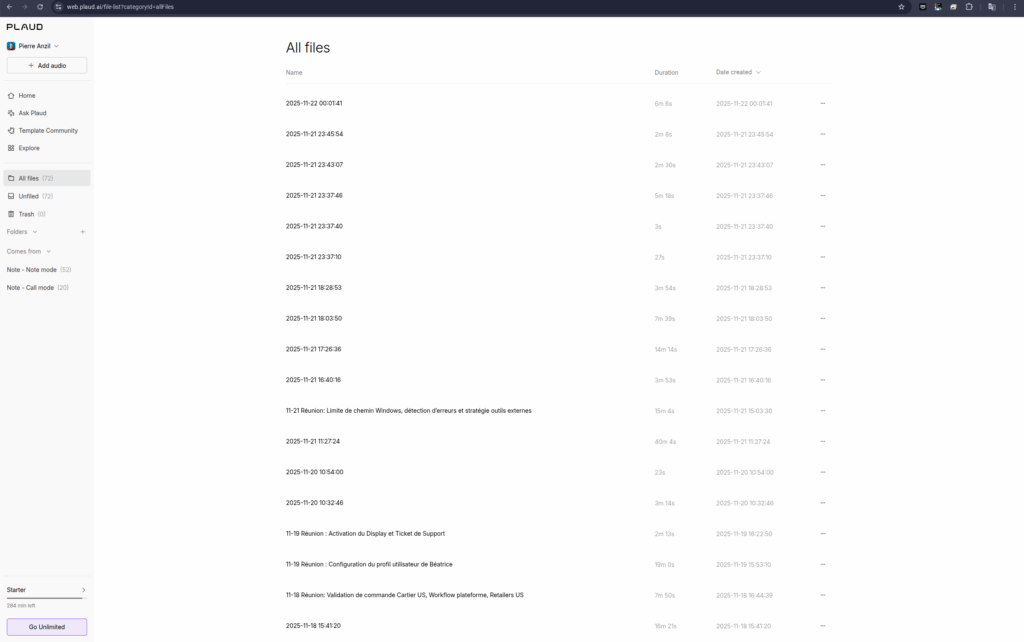
This works similarly to Google’s online recorder portal (https://recorder.google.com/), which provides the same convenience for Pixel users: an easy way to browse, search, and access recordings from a desktop interface. PLAUD’s web dashboard offers the same advantage—ideal for users who prefer to review or organize long recordings on a laptop rather than on a smartphone.

Comparison between Hidden Voice Recorder With Google Recorder on Pixel
Comparing a dedicated hidden voice recorder to a smartphone application is instructive. Both solutions were used in identical situations.
Advantages observed with PLAUD
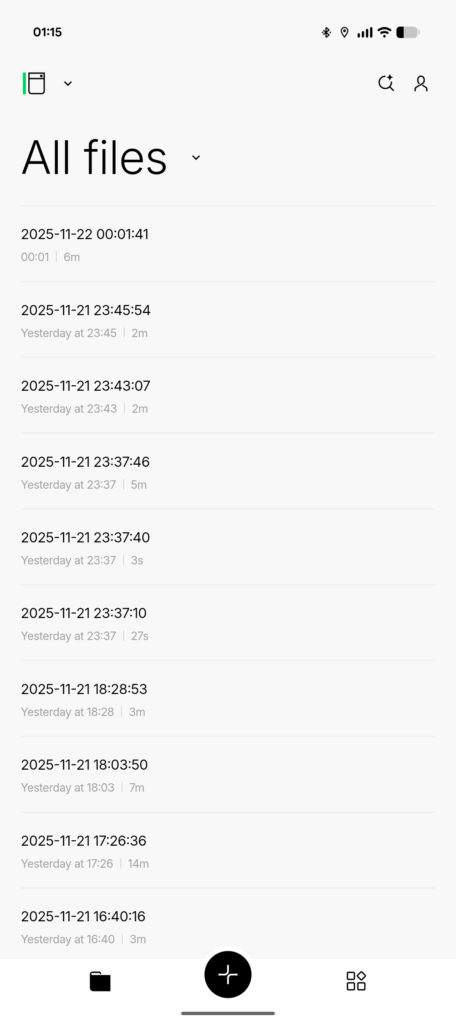
- Much longer recording duration
- Discreet form factor
- No impact on phone battery
- Works even when the phone is busy or locked
- Uniform performance across different phones
Advantages observed with Google Recorder

- Real-time on-screen transcription
- Unlimited use without subscription
- Searchable words inside transcripts
- No transfer step required
Audio differences
There is a notable functional difference when it comes to speaker separation and language detection. On Pixel devices, enabling automatic language detection typically disables speaker identification, meaning the transcript won’t label different speakers during multilingual or mixed conversations.
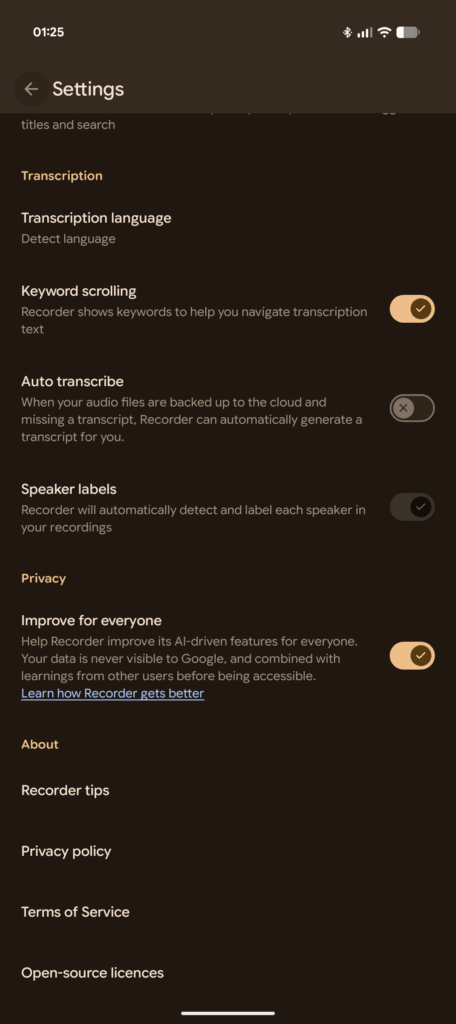
PLAUD Note, on the other hand, is capable of doing both simultaneously:
- language detection, and
- speaker identification within the same transcript
This means each speaker is clearly distinguished, even in multilingual contexts. Having speakers visibly separated in the transcription dramatically improves readability and comprehension—especially during interviews, meetings, group discussions, or any real-world situation where several people speak in different languages or accents. In this regard, PLAUD provides a notable advantage in terms of transcription clarity and structure.
Real-World Transcription Test: The “Wall of Text” vs. The Script
To put these technical differences to the test, I recorded the exact same team handover meeting using both the PLAUD Note and a Google Pixel 9 Pro Fold. The contrast in the final output was stark. While the Pixel captured some words accurately, it presented them as a dense “wall of text”grouping multiple exchanges into long paragraphs that merged different speakers together. It required significant manual editing to disentangle who was assigning tasks and who was accepting them.
Conversely, the PLAUD Note produced a result that looked like a ready-to-read film script. The diarization was nearly flawless, breaking down the conversation line-by-line and correctly attributing rapid-fire responses to “Speaker 1” and “Speaker 2.” For professional use, like tracking which colleague promised to update a specific project column, the PLAUD transcript was immediately usable, whereas the Pixel’s output was merely a raw data dump requiring cleanup.
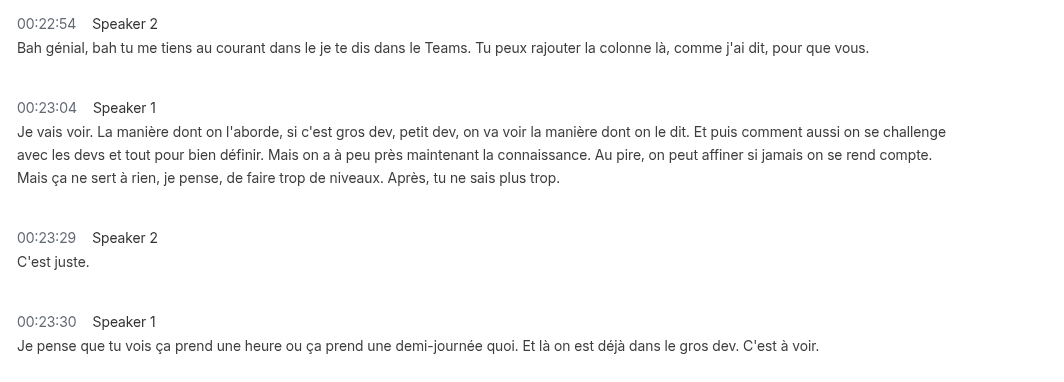
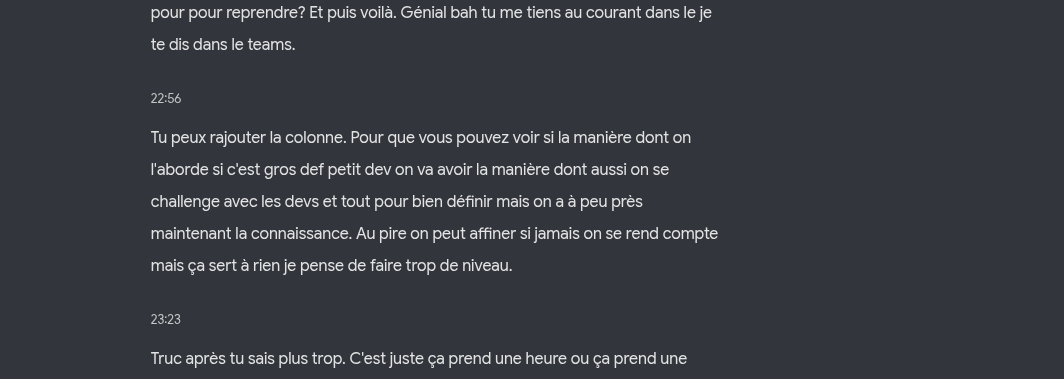
Conclusion of the comparison
Google Pixel Score: 60% (Passing Grade). It captures the audio, but the “wall of text” format means you fail on presentation. You are left with a “fixer-upper” that requires 15 minutes of manual formatting to add line breaks and names. And it fails to understand some context.
PLAUD Note Score: 98% (A+ Grade). It captures the audio and the context. The transcript arrived fully structured with zero editing required.
Strengths and Limitations Observed During Testing
Strengths
- Very long battery life
- Simple one-button operation
- Discreet and thin design
- Fast file transfer
- Good speech clarity
- Effective transcription
Limitations
- Transcription requires an internet connection
- No live transcription on the device itself
- An additional object to carry
- The magnetic accessory is optional but necessary for call recording
Who Might Prefer This Hidden Voice Recorder?
Different profiles may or may not find interest in such a device.
PLAUD may appeal to users who:
- Attend long events
- Prefer a discreet device rather than using a phone
- Need a dedicated recorder that cannot be interrupted by notifications
- Handle multi-hour sessions regularly
- Want a backup device independent from their phone
- Need high transcription accuracy in post-processing
On the other hand, those who always have their smartphone at hand and rarely exceed one hour of recording may feel that a mobile app is sufficient.
Conclusion
The PLAUD Note proves reliable: long battery life, fast wireless transfers, unlimited cloud sync, and clear, structured transcription. In the final test, the Google Pixel produced an unstructured “wall of text,” while PLAUD delivered a clean, speaker-separated transcript ready to use.
For short, casual recordings a smartphone is enough.
For long sessions, discreet use, and accurate transcription, the PLAUD Note is simply the more effective tool.
Explore More Technology Reviews
While exploring the latest in wearable tech, don’t miss our in-depth reviews of the top projectors on the market.


